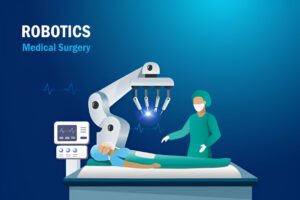The Future is Now in Orthopedics Robotic vs. Traditional Surgery Recovery

Orthopedic surgery has come a long way since its inception, evolving from rudimentary procedures to the sophisticated techniques we see today. With the dawn of robotic technology in the medical field, the landscape of orthopedic surgery is changing rapidly. For patients, health enthusiasts, and medical professionals alike, understanding these advancements is crucial. This blog post will explore the differences between robotic and traditional orthopedic surgery, focusing on recovery, outcomes, and patient experiences.
The Evolution of Orthopedic Surgery

Orthopedic surgery has a rich history, dating back to ancient times when bones were set using simple splints. Fast forward to the 20th century, and we see significant advancements in surgical techniques and tools. The introduction of arthroscopy in the 1960s revolutionized the field, allowing minimally invasive procedures. Today, technology plays an even greater role, with robotics becoming increasingly prevalent in operating rooms.
The shift towards robotic surgery marks a new era in orthopedics, promising more precision and potentially better outcomes for patients. However, traditional methods are still widely used and continue to offer reliable results. The question is, how do these two approaches compare, especially when it comes to recovery?
Understanding Robotic Orthopedic Surgery
Robotic orthopedic surgery uses advanced robotic systems to assist surgeons in performing precise procedures. These systems typically consist of a robotic arm and a computer console that the surgeon operates. The technology allows for enhanced visualization and greater accuracy in bone alignment and placement of implants.
One of the main advantages of robotic surgery is its minimally invasive nature. Smaller incisions mean less damage to surrounding tissues, which can lead to faster recovery times. Additionally, robotic systems can provide real-time feedback, helping surgeons make more informed decisions during surgery. This precision may result in better long-term outcomes for patients.
Despite its benefits, robotic surgery is not without its challenges. The technology is costly, which can impact the overall cost of the procedure. Furthermore, not all hospitals and surgeons have access to robotic systems, limiting its availability to patients.
Traditional Orthopedic Surgery Techniques
Traditional orthopedic surgery techniques have been refined over decades and are well-established in the medical community. These methods often involve larger incisions and more direct access to the surgical site, allowing surgeons to have a clear view and feel of the area being operated on.
The benefits of traditional surgery include its widespread availability and lower cost compared to robotic surgery. Many surgeons are highly skilled in these techniques and can achieve excellent results. However, the more invasive nature of these procedures can lead to longer recovery times and increased risk of complications.
Limitations of traditional surgery include the potential for greater tissue damage, which can prolong the healing process. Additionally, the lack of technological assistance means that outcomes can vary depending on the surgeon’s experience and skill level.
A Comparative Analysis
When comparing robotic and traditional orthopedic surgery, several factors come into play. Recovery time is a significant consideration for patients, and robotic surgery often has the edge in this area. The minimally invasive approach typically results in less pain, reduced scarring, and quicker return to normal activities.
In terms of outcomes, both techniques can achieve excellent results, but robotic surgery’s precision may offer an advantage in complex cases. The risk of complications is generally lower with robotic surgery due to smaller incisions and less tissue trauma. However, traditional surgery remains a reliable option, especially in more straightforward procedures.
Cost is another critical factor in the comparison. Robotic surgery tends to be more expensive due to the high cost of technology and equipment. This can be a barrier for some patients, especially those without comprehensive health insurance coverage.
Patient Stories and Testimonials
Hearing from patients who have undergone both types of surgery provides valuable insights into the differences in recovery and outcomes. Jane, a 55-year-old knee replacement patient, shared her experience with robotic surgery, highlighting the minimal pain and swift recovery that allowed her to return to work in just three weeks.
In contrast, Tom, who underwent traditional hip replacement surgery, recounted a longer recovery period with more physical therapy sessions. Despite this, he was satisfied with the final outcome, emphasizing the importance of a skilled surgeon.
These stories underscore that while robotic surgery can offer a more comfortable recovery, traditional surgery is still a viable and effective option for many patients.
Expert Opinions
Orthopedic surgeons have unique insights into the future of robotic surgery and its impact on healthcare. Dr. Lisa Chen, an orthopedic surgeon with over 20 years of experience, believes that as technology advances, robotic surgery will become more accessible and widely adopted.
Dr. Chen highlights the importance of training and education for surgeons to ensure optimal use of robotic systems. She also notes that while robotic surgery is promising, traditional techniques will remain relevant, especially in less complex cases.
Dr. Michael Rivera, another seasoned orthopedic surgeon, emphasizes the need for a balanced approach. He believes that both robotic and traditional surgeries have their place in orthopedics, and the choice should be tailored to the patient’s specific needs and circumstances.
In conclusion, both robotic and traditional orthopedic surgeries have their unique advantages and limitations. Robotic surgery offers precision and faster recovery, but it comes at a higher cost and limited availability. Traditional surgery remains a trusted and accessible option, with skilled surgeons achieving excellent outcomes.
For patients considering surgery, it’s essential to weigh the pros and cons of each approach and discuss options with their healthcare provider. Factors such as the complexity of the procedure, the surgeon’s expertise, and the patient’s health and preferences should guide the decision-making process.
To further explore the topic, consider consulting additional resources or seeking a second opinion from a qualified orthopedic specialist. Understanding the nuances of each surgical method will empower patients to make informed choices about their healthcare.

